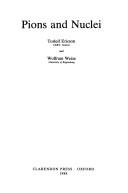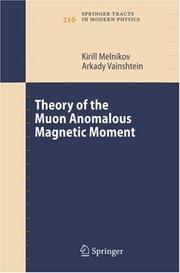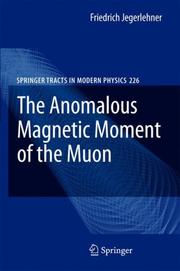| Listing 1 - 10 of 18 | << page >> |
Sort by
|
Multi
ISSN: 11042516 ISBN: 9155439551 Year: 1997 Publisher: Uppsala : Almqvist & Wiksell : Acta universitatis upsaliensis,
Abstract | Keywords | Export | Availability | Bookmark
 Loading...
Loading...Choose an application
- Reference Manager
- EndNote
- RefWorks (Direct export to RefWorks)

ISBN: 0198520085 Year: 1988 Publisher: Oxford : Clarendon Press : Oxford University Press,
Abstract | Keywords | Export | Availability | Bookmark
 Loading...
Loading...Choose an application
- Reference Manager
- EndNote
- RefWorks (Direct export to RefWorks)
The pion plays an outstanding role in nuclear physics as a generator of the nuclear force and as an important part of the nuclear many-body problem. At the same time, pion beams are used as probes to explore the nucleus and its interactions. As pion physics has matured over the years, a rich and diverse variety of phenomena has been uncovered. The aim of this book is to examine the underlying physical picture behind these phenomena in a systematic and coherent way. The authors emphasize the interplay between physical concepts and experimental facts more than the formal tools, which are presented in a series of appendices. The book is directed towards advanced students as well as research workers.
Pions. --- Pions --- 539.14 --- Pi mesons --- Sigma mesons --- Mesons --- Particles (Nuclear physics) --- Strange particles --- Kaons --- Muons --- Nuclei --- 539.14 Nuclei
Book
ISBN: 3540138803 0387138803 3540390774 9783540138808 Year: 1984 Volume: 211 Publisher: Berlin Springer
Abstract | Keywords | Export | Availability | Bookmark
 Loading...
Loading...Choose an application
- Reference Manager
- EndNote
- RefWorks (Direct export to RefWorks)
539.126 <063> --- Mesons. Hyperons--Congressen --- Resonance --- Nuclear magnetic resonance --- Congresses. --- 539.126 <063> Mesons. Hyperons--Congressen
Book
ISBN: 0123606012 032315171X 9780123606013 Year: 1977 Publisher: New York : Academic Press,
Abstract | Keywords | Export | Availability | Bookmark
 Loading...
Loading...Choose an application
- Reference Manager
- EndNote
- RefWorks (Direct export to RefWorks)
Muons. --- Muons --- Mu mesons --- Kaons --- Pions --- 539.1 --- 539.1 Nuclear physics. Atomic physics. Molecular physics --- Nuclear physics. Atomic physics. Molecular physics --- Leptons (Nuclear physics) --- Mesons
Book
ISBN: 3662586290 3662586274 Year: 2019 Publisher: Berlin, Heidelberg : Springer Berlin Heidelberg : Imprint: Springer,
Abstract | Keywords | Export | Availability | Bookmark
 Loading...
Loading...Choose an application
- Reference Manager
- EndNote
- RefWorks (Direct export to RefWorks)
The second edition of this monograph discusses the usefulness of heavy flavor as a probe of TeV-scale physics, exploring a number of recently-uncovered “flavor anomalies” that are suggestive of possible TeV-scale phenomena. The large human endeavor at the Large Hadron Collider has not turned up any New Physics, except the last particle of the Standard Model, the Higgs boson. Revised and updated throughout, this book puts the first results from the LHC into perspective and provides an outlook for a new era of flavor physics. The author readdresses many questions raised in the first edition and poses new ones. As before, the experimental perspective is taken, with a focus on processes, rather than theories or models, as a basis for exploration, and two-thirds of the book is concerned with b -^ s or bs sb transitions. In the face of the advent of Belle II and other flavor experiments, this book becomes a part of a dialogue between the energy/collider and intensity/flavor frontiers that will continue over the coming decade. Researchers with an interest in modern particle physics will find this book particularly valuable.
Quantum theory. --- Elementary Particles, Quantum Field Theory. --- Quantum dynamics --- Quantum mechanics --- Quantum physics --- Physics --- Mechanics --- Thermodynamics --- Particles (Nuclear physics) --- Quantum flavor dynamics. --- B mesons. --- CP violation (Nuclear physics) --- Flavor. --- Charge conjugation parity violation --- Violation, Charge conjugation parity --- Symmetry (Physics) --- Beauty mesons --- Bottom mesons --- Mesons --- Dynamics, Quantum flavor --- Flavor dynamics, Quantum --- Quantum theory --- Quarks --- Flavor (Nuclear physics) --- Flavor models (Nuclear physics) --- Top quark models --- Truth models (Nuclear physics) --- Elementary particles (Physics). --- Quantum field theory. --- Relativistic quantum field theory --- Field theory (Physics) --- Relativity (Physics) --- Elementary particles (Physics) --- High energy physics --- Nuclear particles --- Nucleons --- Nuclear physics
Multi
ISBN: 9783031227530 9783031227523 9783031227547 9783031227554 Year: 2023 Publisher: Cham Springer International Publishing
Abstract | Keywords | Export | Availability | Bookmark
 Loading...
Loading...Choose an application
- Reference Manager
- EndNote
- RefWorks (Direct export to RefWorks)
This book presents the latest results on the branching fraction and phase space distribution of B0 and Bs0 decays into final states including excited neutral charm mesons. This work represents four years of research, and the book describes in detail all the necessary steps and techniques required to perform a physics analysis of the data recorded by the LHCb experiment in the years 2016–2018. Although the results presented in this book represent the first measurement of such decays, the text is written in a manner accessible to Ph.D. students and early career researchers. Thus, all the contents included in this book are described in a pedagogical way, including technical details that would allow the results to be reproduced in future. In addition to the methodology used to perform these measurements, the book also includes a description of the theoretical background required to interpret the results presented, as well as a technical description of the LHCb detector, which provided the data sample used in this study.
Quantum mechanics. Quantumfield theory --- Experimental nuclear and elementary particle physics --- Elementary particles --- Nuclear physics --- elementaire deeltjes --- kwantumleer --- fysica --- atoomfysica --- Mesons. --- Hadrons --- Decay.
Book
ISBN: 9155422837 Year: 1988 Volume: vol 23 23 Publisher: Uppsala : Almqvist & Wiksell : Acta universitatis upsaliensis,
Abstract | Keywords | Export | Availability | Bookmark
 Loading...
Loading...Choose an application
- Reference Manager
- EndNote
- RefWorks (Direct export to RefWorks)
Muons --- -Deep inelastic collisions --- Nuclear structure --- Structure, Nuclear --- Nuclear physics --- Damp inelastic collisions --- Deep inelastic scattering --- Deep inelastic transfers --- Incomplete fusion --- Inelastic collisions, Damp --- Inelastic collisions, Deep --- Quasi-fission --- Relaxed peak process (Nuclear physics) --- Strongly damped collision (Nuclear physics) --- Collisions (Nuclear physics) --- Nuclear reactions --- Mu mesons --- Kaons --- Leptons (Nuclear physics) --- Mesons --- Pions --- Scattering --- -Measurement --- Deep inelastic collisions --- Scattering&delete& --- Measurement --- Collisions (physique nucleaire) --- Diffusion

ISBN: 9783540328063 3540328068 3540328076 Year: 2006 Publisher: Berlin : Springer,
Abstract | Keywords | Export | Availability | Bookmark
 Loading...
Loading...Choose an application
- Reference Manager
- EndNote
- RefWorks (Direct export to RefWorks)
The theory of the muon anomalous magnetic is ""particle physics in a nutshell"" and as such is interesting, exciting and difficult. The current precision of the experimental value for this quantity, improved significantly in the past several years due to experiment E821 at Brookhaven National Laboratory, is so high that a large number of subtle effects not relevant previously, become important for the interpretation of the experimental result. The theory of the muon anomalous magnetic moment is at the cutting edge of current research in particle physics and includes multiloop calculations in b
Muons. --- Muons --- Magnetic anomalies. --- Physics. --- Magnetic anomalies --- Nuclear Physics --- Physics --- Physical Sciences & Mathematics --- Anomalies, Geomagnetic --- Anomalies, Magnetic --- Geomagnetic anomalies --- Mu mesons --- Nuclear physics. --- Particle and Nuclear Physics. --- Atomic nuclei --- Atoms, Nuclei of --- Nucleus of the atom --- Natural philosophy --- Philosophy, Natural --- Physical sciences --- Dynamics --- Geomagnetism --- Kaons --- Leptons (Nuclear physics) --- Mesons --- Pions --- Particles (Nuclear physics) --- Elementary particles (Physics) --- High energy physics --- Nuclear particles --- Nucleons --- Nuclear physics

ISSN: 00813869 ISBN: 9783540726333 3540726330 3540726349 Year: 2008 Volume: 226 Publisher: Berlin, Heidelberg : Springer Berlin Heidelberg : Imprint: Springer,
Abstract | Keywords | Export | Availability | Bookmark
 Loading...
Loading...Choose an application
- Reference Manager
- EndNote
- RefWorks (Direct export to RefWorks)
It seems to be a strange enterprise to attempt write a physics book about a single number. It was not my idea to do so, but why not. In mathematics, maybe, one would write a book about ?. Certainly, the muon’s anomalous magnetic moment is a very special number and today re?ects almost the full spectrum of e?ects incorporated in today’s Standard Model (SM) of fun- mental interactions, including the electromagnetic, the weak and the strong forces. The muon g? 2, how it is also called, is a truly fascinating theme both from an experimental and from a theoretical point of view and it has played a crucial role in the development of QED which ?nally developed into the SM by successive inclusion of the weak and the strong interactions. The topic has fascinated a large number of particle physicists, last but not least it was always a benchmark for theory as a monitor for e?ects beyond what was known at the time. As an example, nobody could believe that a muon is just a heavy version of an electron; why should nature repeat itself, it hardly can make sense.
Muons. --- Nuclear moments. --- Magnetic anomalies. --- Muons --- Moments nucléaires --- Periodicals --- Cycles. --- Quantum theory. --- Physics --- Astrophysics --- General and Others --- Particle Physics --- Physics. --- Nuclear physics. --- Particle and Nuclear Physics. --- Atomic nuclei --- Atoms, Nuclei of --- Nucleus of the atom --- Natural philosophy --- Philosophy, Natural --- Physical sciences --- Dynamics --- Anomalies, Geomagnetic --- Anomalies, Magnetic --- Geomagnetic anomalies --- Geomagnetism --- Nuclear physics --- Mu mesons --- Kaons --- Leptons (Nuclear physics) --- Mesons --- Pions
Book
ISBN: 0691081158 1322884560 0691619115 1400867444 0691081298 9781400867448 9780691619118 9780691081151 9780691081298 Year: 1973 Publisher: Princeton, New Jersey
Abstract | Keywords | Export | Availability | Bookmark
 Loading...
Loading...Choose an application
- Reference Manager
- EndNote
- RefWorks (Direct export to RefWorks)
Synthesizing the theoretical and experimental advances in pion-nucleon interactions over approximately the last twelve years, the authors offer here a timely account of the hadronic interactions of pions and nucleons and of the structure of nucleons. Because of the hadronic SU3 symmetry, the book also treats the structure of baryons in general, and so contains much material external to the specific field of pion-nucleon interactions. Thus the book's subject can be stated as the hadronic structure of baryons as illustrated particularly by pion-nucleon interaction.Following an introductory discussion of isotopic spin, the authors proceed to chapters that treat low energy pion scattering by nucleons and the photoproduction of pions; forward and fixed momentum transfer dispersion relations; analytic properties of scattering amplitudes; formation of nucleon resonances; symmetries and classification of particles and resonances; current algebra, sum rules, and superconvergence relations; scattering at higher energies; pion-nucleon dynamics; pion-nucleon inelastic scattering; and the form factors of the nucleon and the pion.Each chapter is followed by abundant references to the original literature. The level of the writing is suitable for students at the graduate level, and the presentation is even and self-contained. On balance, the authors have prepared a useful consolidation and review of this difficult and changing area of investigation.Originally published in 1973.The Princeton Legacy Library uses the latest print-on-demand technology to again make available previously out-of-print books from the distinguished backlist of Princeton University Press. These editions preserve the original texts of these important books while presenting them in durable paperback and hardcover editions. The goal of the Princeton Legacy Library is to vastly increase access to the rich scholarly heritage found in the thousands of books published by Princeton University Press since its founding in 1905.
Mesons --- Baryons. --- Photonuclear reactions. --- Chadwick-Goldhaber effect --- Goldhaber-Chadwick effect --- Photodisintegration --- Nuclear reactions --- Photons --- Fermions --- Hadrons --- Heavy particles (Nuclear physics) --- Scattering (Physics) --- Scattering. --- Pions --- Pion-nucleon interactions. --- Mésons --- Réactions photonucléaires --- Interactions pion-nucléon --- Baryons --- Pions (particules) --- Interactions pion-nucléon. --- Diffusion --- Mésons --- Réactions photonucléaires --- Interactions pion-nucléon --- Interactions pion-nucléon.
| Listing 1 - 10 of 18 | << page >> |
Sort by
|

 Search
Search Feedback
Feedback About UniCat
About UniCat  Help
Help News
News